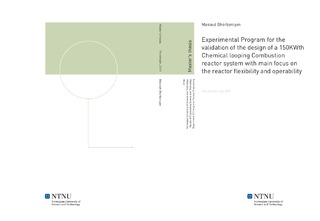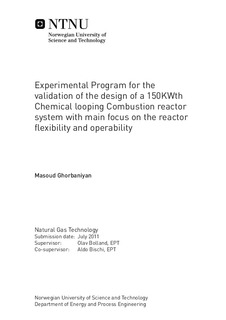| dc.description.abstract | Chemical Looping Combustion is one of the most promising way to limit the CO2 release to the atmosphere among the other technologies for Carbon Capture and Storage (CCS). It constitutes an indirect fuel combustion strategy, in which metal oxide is used as oxygen carrier, to transfer oxygen from the combustion air to the fuel, avoiding direct contact between air and fuel. It is basically an unmixed combustion process (fuel and air are never mixed) whose flue gases are mainly CO2 and steam. Thus, after condensation, the carbon dioxide can be easily separated from the exhaust.SINTEF Energy Research and the Norwegian University of Science and Technology (NTNU) have designed a 150kWth second generation chemical looping combustion reactor system. It consists of a double loop circulating fluidized bed (DLCFB) reactor system where both the air reactor and the fuel reactor are Circulating Fluidized Beds (CFB) meant to work in the fast fluidization regime and interconnected by divided loop-seals and a bottom extraction to achieve high solids circulation and be flexible in operation. The main purpose of this project is to be strongly industrial oriented in order to make the step from lab-scale to industrial application easier. A Cold Flow Model (CFM) has been built to verify the design of the CLC reactor system.CFM consists of two reactors, the fuel and the air reactor, with different diameters, each one having a loop seal . No chemical reaction happens inside the CFM, because its main goal is to have the understanding of the hydrodynamics of the system.An experimental campaign was performed in order to find the best conditions for the solid flux, reaching stability, and the proper flow regimes for the coupled reactors in the CFM. An investigation and mapping of the operating area of the coupled reactors was the target of the experiments.As the first step and for further research, the best set of operating conditions is selected by considering the stability and solid flux in order to meet the design targets. This experiment is used as the reference case and later all other operational modes in the cold flow model which resembles CLC are evaluated against the base data obtained.Different operational modes of Chemical Looping Combustion were designed by means of the CFM to validate the CLC reactor system design. A significant effort was done to reach part-load , maximum power , maximum fuel reactor concentration and reforming to define the best operational window. In each of the mentioned experiments pressure profiles and concentration of the solids are compared to the reference case of the CFM.As long as the loop seal plays a key role in the operation of the CFB, for assuring the solids movement in an endless loop, series of experiments were performed in the CFM in order to map the operational window of the loop seal. The sensitivity of the loop seal is evaluated by pressure difference in the bottom of the fuel reactor and air reactor during the operation of the CFM to obtain an operational window for the loop seal. For the last step, the effects of the total mass inventory circulating in the system for five different operational modes were investigated by increasing and decreasing the inventory. For each case the pressure profiles and concentration of the solids is compared with the reference case and the results are shown in this thesis work. | nb_NO |

